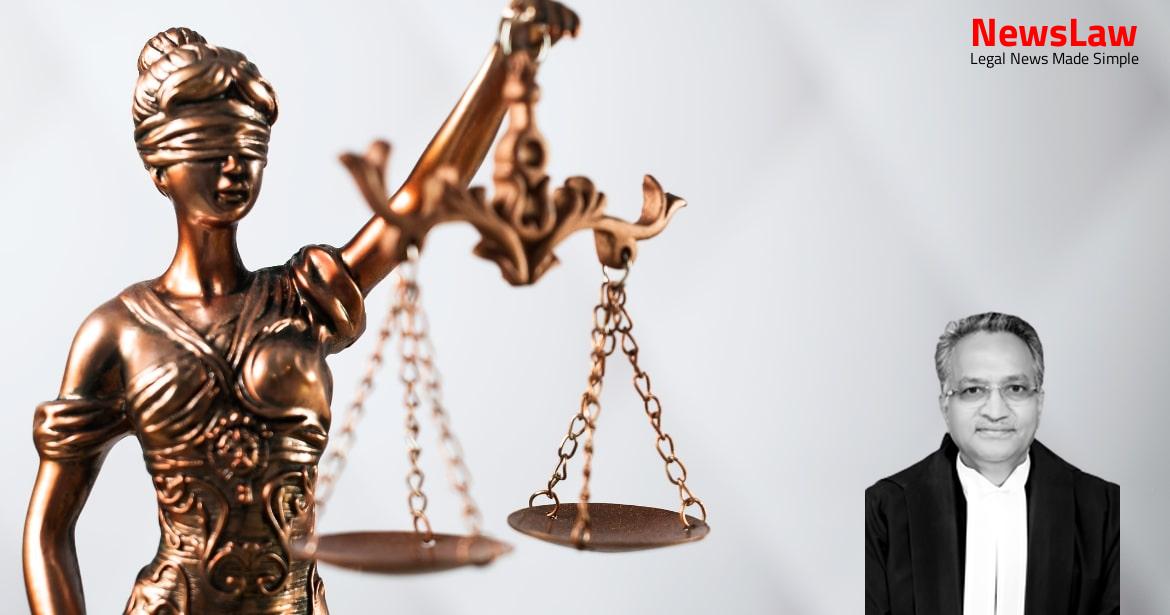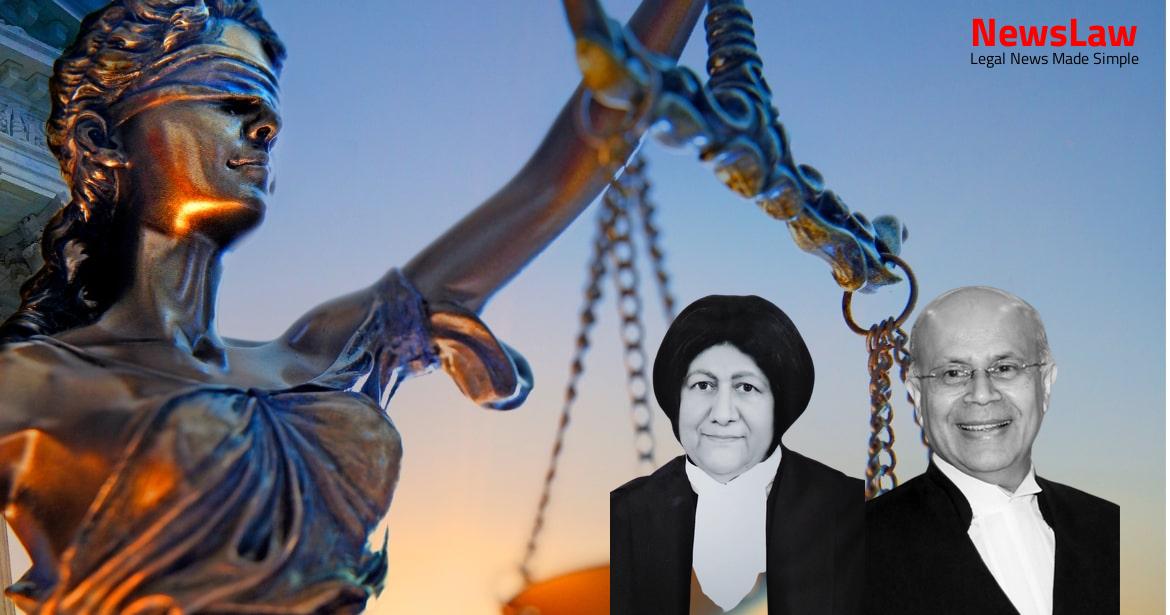The court’s thorough legal analysis in this case delves into the intricacies of sentencing guidelines, specifically evaluating the imposition of a death penalty. The commutation of the death penalty to life imprisonment showcases a nuanced understanding of the gravity of the offense and the need for proportional punishment. Stay tuned to uncover the intricate legal reasoning behind this pivotal decision.
Facts
- The prosecution’s case was based on circumstantial evidence.
- The victim was last seen in the company of the appellant.
- The victim’s dead body was recovered based on information provided by the appellant.
- The appellant failed to provide a satisfactory explanation for his whereabouts and knowledge of the dead body’s location.
- Medical and scientific evidence supported the prosecution’s accusations.
- The appellant claimed he was falsely implicated due to enmity with the families of the deceased and other witnesses over a land dispute.
- The Trial Court found the appellant guilty of enticing a seven-year-old girl to pick lychee fruits, raping her, causing her death, and dumping her body near a bridge on the riverbank.
- The High Court upheld the Trial Court’s decision and confirmed the death sentence awarded to the appellant for the offence under Section 302 IPC.
- There were arguments regarding delay in lodging the FIR, which the High Court reasoned was due to the search for the deceased child in the village.
- The High Court held that the witnesses, though related to the deceased, were not considered interested witnesses when their testimonies were found to be natural.
- The Trial Court observed spot marks where the appellant committed the crime, and the High Court deemed the testimonies of key witnesses trustworthy and untutored.
Also Read: Legal Analysis on Alleged Multiple Agreements in Property Sale Case
Issue
- Two major points for determination in the appeals
- Questions to be asked and answered in relation to the guidelines for sentencing
- First point: Whether the conviction of the appellant requires interference
- Second point: Whether the death sentence awarded to the appellant should be maintained or substituted
Also Read: Ensuring Maintenance Rights: Court’s Legal Analysis
Arguments
- The learned counsel for the appellant has raised several arguments questioning the findings leading to the conviction of the appellant and the sentence awarded to him.
- Reference is made to the principles laid down in Bachan Singh case, emphasizing the absence of mitigating circumstances and the presence of aggravating circumstances against the appellant.
- The victim, a 7-year-old child, is said to have reposed complete confidence in the appellant due to their close proximity as neighbors.
- It is argued that the burden was on the appellant to explain what happened to the victim after she was last seen with him, given that those facts were within his special knowledge.
- Challenges are raised regarding the legality of the appellant’s arrest, including inconsistencies in the statement of a key witness and the delayed preparation of the arrest memo.
- Prosecution referred to the heinous nature of the crime and urged for the death sentence for the accused-appellant.
- Adverse inference suggested for prosecution not examining certain persons, which was deemed illogical.
- All necessary witnesses examined by the prosecution, including forensic evidence of spermatozoa found on the deceased’s underwear.
- Appellant’s sentence questioned, citing mitigating circumstances like weak chain of evidence and poor background.
- Concurrent findings on guilt of the appellant deemed solid and no interference necessary.
- Circumstantial evidence in the case met the ‘panchsheel principles’ and upheld the conviction.
- Absence of evidence connecting the accused to the murder made it impossible to find guilt under Section 302 of the Penal Code.
- Reference made to expert evidence and triple tests from previous cases to support capital punishment.
- Incriminating portions of custodial disclosure considered inadmissible per case precedent.
- Inconsistencies in witness testimonies and minor factors deemed insignificant in creating reasonable doubt.
- Importance given to corroborative scientific evidence and post-mortem report in establishing facts of the case.
- Fixed term sentences in similar cases cited as reference for possible sentencing in this case.
- Rival submissions thoroughly considered and material on record examined.
- No assistance found for the appellant in arguments referencing previous case precedent.
- Nature of the crime and potential impact on society highlighted in support of maintaining harsh sentencing even if not considering ‘rarest of rare’ paradigm.
Also Read: Legal Analysis: High Court’s Critique of Authority Actions
Analysis
- In the discussed part of the judgment, various cases and principles related to the imposition of death sentence versus life imprisonment in heinous crimes like murder and rape have been analyzed.
- Key cases such as Machhi Singh, Dhananjoy Chatterjee, Shatrughna Baban Meshram, Rajendra Pralhadrao Wasnik, and many others have been referred to in determining the appropriate sentence based on the circumstances of the crime and the criminal.
- The concept of ‘rarest of rare’ cases where death penalty is imposed as an exception rather than the rule has been emphasized, with specific guidelines provided by the legislative policy outlined in Section 354(3) of the Criminal Procedure Code (CrPC).
- The necessity of considering reformation, rehabilitation, and reintegration of the convict into society alongside the severity of the crime in determining the appropriate sentence has been highlighted.
- The judicial approach towards circumstantial evidence, expert witness testimonies, burdens of proof, and constitutional provisions related to sentencing in extreme cases have been discussed in detail.
- Overall, a cautious and humane approach towards imposing the death penalty, ensuring a balance between societal justice, individual rights, and the gravity of the offense, is evident throughout the analyzed part of the judgment.
- The Supreme Court has enlarged appellate jurisdiction in criminal matters as per the Supreme Court (Enlargement of Criminal Appellate Jurisdiction) Act, 1970.
- The Act allows appeals to the Supreme Court from High Court judgments, final orders, or sentences in criminal proceedings under specified conditions.
- High Court decisions such as reversal of acquittal and sentencing to imprisonment for life or not less than ten years can be appealed to the Supreme Court.
- Special leave to appeal can be granted by the Supreme Court at its discretion for judgments, decrees, determinations, sentences, or orders from any court or tribunal in India.
- The Supreme Court can have appellate jurisdiction over cases where a High Court has reversed an order of acquittal and sentenced the accused person to death.
- The appellant was around 33-34 years old at the time of the crime in 2015.
- All substantive sentences shall run concurrently for the appellant.
- Imprisonment for life is awarded for the offence under Section 302 IPC, with a minimum of 30 years actual imprisonment.
- The punishment of imprisonment for life without premature release/remission before a substantial length of time is justified in cases of similar nature.
Decision
- The death sentence awarded to the appellant under Section 302 IPC is commuted to life imprisonment without the possibility of premature release or remission for 30 years.
- The other sentences, including the fine amount and default stipulations, are confirmed.
- The direction to pay half of the fine amount to the mother of the deceased girl is also confirmed.
- All substantive sentences for the appellant will run concurrently.
- The appeals are partly allowed with the convictions under Sections 376, 302, 201 IPC, and Section 5/6 POCSO upheld, except for the death sentence under Section 302 IPC.
Case Title: PAPPU Vs. THE STATE OF UTTAR PRADESH (2022 INSC 164)
Case Number: Crl.A. No.-001097-001098 / 2018



